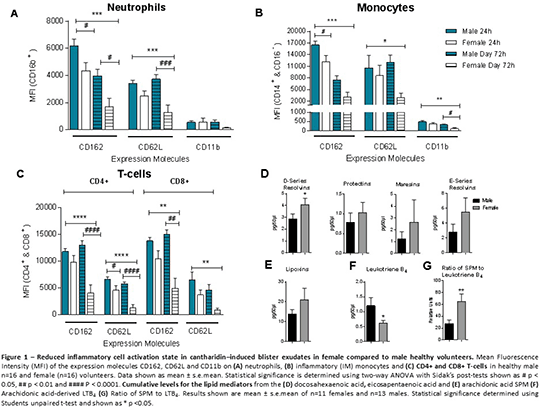Print version
Search Pub Med
| 012P London, UK Pharmacology 2016 |
Accelerated resolution of inflammation underlies sex differences in the inflammatory response and inflammation induced vascular dysfunction in humans
Introduction. Pre-menopausal females, compared to age-matched males, have a lower incidence of cardiovascular disease(1). Both systemic and localised inflammation play a critical role in the progression of cardiovascular disease and much pre-clinical and observational data in humans suggest that differences in inflammation between the sexes exist(2). We investigated prospectively whether inflammation and specifically which components of the inflammatory response might be altered in females compared to males.
Methods. We performed 2 clinical studies with 24 and 32 healthy volunteers. In 12 men and 12 women we assessed systemic inflammatory markers using flow cytometry and vascular function using brachial artery flow mediated dilation (FMD) determined using ultrasound. Responses were assessed prior to and then at 8 and 32h post-typhoid vaccine. In a separate study in 16 male and 16 female healthy volunteers inflammatory exudate and cellular recruitment were measured 24h (acute phase) and 72h (resolution phase) in skin blisters induced with cantharidin. Lipid mediators were measured in plasma and blister fluid using LC-MS/MS.
Results. Typhoid vaccine caused a mild systemic inflammation reflected by a rise in white cell count, specifically neutrophils, at 8h in both sexes that had resolved 24h later. Whilst the circulating cells (particularly the neutrophils) in males at 8h displayed an activated phenotype, the cells of females were unchanged compared to baseline. The cellular activation in males was associated with reductions in FMD response (-1.16±0.5%) whilst in females if anything the FMD response increased (+2.41±0.7%). Cantharidin-induced a fluid-filled blister by 24h in both sexes of a similar volume, however after 72h blisters had resolved only in females (p=0.003). Whilst neutrophil count in the blisters at 24h was similar between the sexes, in females a significant reduction in both monocyte (p=0.003) and lymphocyte count (p=0.011) was evident. A generalised reduction in the activation state of all major leucocytes including neutrophils was evident in the females compared to males (Figure1A-C). These differences in cell recruitment and activation were associated with higher pro-resolving mediator levels including the D-Resolvins, and a reduction in levels of the neutrophil chemoattractant leukotrieneB4 (Figure1D-G).
Conclusions. Our findings suggest that female sex protects against endothelial dysfunction induced by systemic inflammation. This effect is likely due to accelerated resolution of inflammation in females compared to males through elevation of the D-Resolvin pathway.
Trial registration:ClinicalTrials.gov:NCT01582321, NRES:City Road Hampstead Ethics Committee:11/LO/2038.
1. Barrett-Connor E (1997). Circulation. 95(1): 252-264. 2. Lerner DJ and Kannel WB (1986). Am Heart J. 111(2): 383-490.


